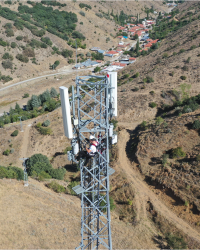Base Station

4.5G
With the 4.5G system, users are provided with an end-to-end voice, data and mass streaming service solutions at anytime, anywhere, based on higher data rates compared to previous generations.
DetailsIt is aimed to maintain the security and emergency communication services needed by the public in a fast and uninterrupted manner through mobile phone operators with the 4.5G connection technologies. To this end, ULAK has established universal and commercial fields everywhere in Turkiye. More than 2.5 million citizens are served with uninterrupted and secure communication with ULAK 4.5G base stations.
It is foreseen that the capabilities gained in the 4th generation wireless communication technology will be an important gain and reference in the domestic and national production of later communication technologies. 4.5G ULAK base stations are planned to be used especially in 5G infrastructure.
4.5G Base Station Products
Remote Radio Unit (RRU)
- 3GPP Version 10 and Version 11.
- 800 MHz (Band-20) & 1800 MHz (Band-3) & 2600 MHz (Band-7) Frequency Bands (Roadmap: 2100 MHz (Band-1))
- 1800/2600 MHz RRU TX/RX Mode: 4T4R (40*4 W)
- IBW (Instantaneous Bandwidth) 800/1800 MHz: 30 MHz
- IBW (Instantaneous Bandwidth) 2600 MHz: 40 MHz
- Power Consumption (800 MHz): 200W typical / 300W maximum
- Power Consumption (1800 MHz): 400W typical / 700W maximum
- Power Consumption (2600 MHz): 450W typical / 750W maximum
- Operating Voltage: Nominal -48V (-36V / -60V)
- Operating Temperature: -30°C to +55°C (Operating) /-40°C to +85°C (Storage)
- Meets IP65 Protection Class requirements. (Protection from Wind, Rain and Dust)
Thanks to the RRU (Remote Radio Unit), operations required for the propagation of high frequency signals are carried out. Remote Radio Unit, which can support 1.4, 3, 5, 10, 15, 20 MHz channel bandwidths, has 2x2 and 4x4 options depending on the number of receivers and transponders. RRU can provide a maximum of 4x40W RF output power.
Baseband Unit (BBU)
- 4x4 20 MHz LTE Capacity
- Support DL 4*4/4*2 MIMO, Carrier Aggregation 2CC/3CC, DL 256QAM, VoLTE, UL 64QAM, Mobility Load Balancing
- LATEST Features: ANR (Intra-RAT, Inter-RAT), PCI Collision Detection, Automatic PCI Planning
- Up to 1 Gbps Transport Capacity with F/O and Copper Ethernet
- Radio Resource Management (RRM)
- Up to 18 CPRI Connections with 3 Capacity Cards
- Signal processing support up to 240 MHz per card
- 300 Mbps Total Output (2x2, 2 CA)
- 600 Mbps Total Output (4x4, 2 CA)
- 900 Mbps Total Output (4x4, 3 CA)
- 10A Maximum Current (@48 VDC)
- -30°C to +55°C (operation) /-30°C to +70°C (Storage)
- Power Consumption (3 Capacity Cards+1 Transport Cards): 291W typical / 391W maximum
- Operating Voltage: Nominal -48V (-39V / -58V)
- Operating Temperature: -30°C to +55°C (Operating) /-30°C to +70°C (Storage)
- Meets IP20 Protection Class requirements. (Protection from Wind, Rain and Dust)
Designed as a Baseband Unit, the BBU is the unit where all software configurations run, including LTE Layer 1-2-3 middleware. The product, which has 4x4 20 MHz LTE capacity, can perform Radio Resource Management (RRM) operations. It can support up to 18 CPRI Connections in order to enable communication with the RRU, which is the Remote Radio Unit.
Operators Served by Commercial Sites
Turkcell: As the main contractor of the project, we provide service for Turkcell in 419 active sites in total.
Vodafone: As the main contractor of the project, we provide service for Vodafone in 355 active sites in total.
Türk Telekom: Field installations of Türk Telekom ULAK LTE Base Station project started in 2020. Currently, service is provided in the field with 487 ULAK Base Stations in Türk Telekom network.

5G
The 5th generation mobile network is defined as a new global wireless standard. It is a new type of network designed to connect virtually anyone and everything, including machines, objects, and devices.
Details5G is a more capable unified platform than 4.5G. It is planned to be an integrated platform that not only to improve mobile broadband experiences, but also support new services such as mission-critical communications and IoT.
It is also capable of supporting locally all spectrum types (licensed, shared, unlicensed) and bands (low, medium, high), a wide variety of distribution models (from traditional macro-cells to hotspots), and new paths for interconnection.
Significantly low latency is expected to provide instant, real-time access with 5G. For example; there will be a 10x reduction in end-to-end latency up to 1ms.
It is predicted that 5G will continue to affect global economy. A new business volume of $22.8 million was created on this sector and its distribution. The landmark 5G technology is expected to develop rapidly over the next 15 years thanks to the $265 billion annual global 5G CAPEX and R&D investments, and reach full economic impact by 2035, supporting a wide range of industries and potentially reflecting up to $13.1 trillion in goods and services.
5G is designed with the goal of creating technology that can change our lives, including giving us faster download speeds, lower latency, and more capacity and connectivity for billions of devices. With 5G, the end user will be provided with access to new, enhanced experiences such as near-instant access to cloud services, cloud multiplayer gaming, augmented reality shopping, real-time video translation and collaboration.
Apart from these, concepts such as digital twin, VR technology, smart transportation systems, and IoT have also taken their place among the things that we will encounter in our daily life. Controlling this development will only be possible if technology is put into service with domestic means.
In addition to the knowledge and experience gained in 4.5G, the number of domestic and national base stations has increased considerably. With 4.5G ULAK base stations, access to all corners of Turkey continues. In order to use this power in 5G, products and components compatible with both mobile communication technologies are being developed.
World-class 5G patent development studies are also carried out within our organization. It is critical to establish technologies of the future today and to set the standards with a strong engineer staff and R&D studies. 5G will not only break new ground in communication technologies, but will also bring change and development in many areas of our lives, from education to health, from transportation to production.

OAM
OAM server software based on TR-069 manages all configuration information of eNodeB,which is included in the system in the form of configuration tables.
Details- Configuration Management
- Performance Management
- Task Management
- Planned Area
- Data Set Management
- MML Transactions
- Trace Transactions
- Software Management
- License Management
- Security and User Actions
- Alarm Management
- Inventory Management
OAM server software based on TR-069 manages all configuration information of eNodeB, which is included in the system in the form of configuration tables.
OAM server software offers a structure that enables all configurations of eNodeB to be made easily via the xml file and user screens requested by the customers.
- Configuration Management
It contains the configuration information of the device. It provides operations such as writing, reading, and deleting this information. It also supports extracting or importing this information into a template in xml format.
- Performance Management
It initiates or terminates a new performance work on the device. It also collects metric data of this performance work from devices and provides the transition to the NBI layers. There is also a batch management feature.
- Software Management
It does the work of installing new software on the card and RRU devices included in the device.
- Inventory Management
It enables information of different hardware in the device to be read from OSS.
- Security and User Operations
OSS can also be arranged specifically for individuals or groups. In this way, eNodeB or services can be accessed separately. With Ldap support, it allows logging in from a single place.
- Alarm Management
It performs operations of querying the alarms generated on the cards and software layers of the device from OSS/NBI layers.
- Trace Management
It provides data collection from S1, X2, Uu layers in E-UTRAN devices.


